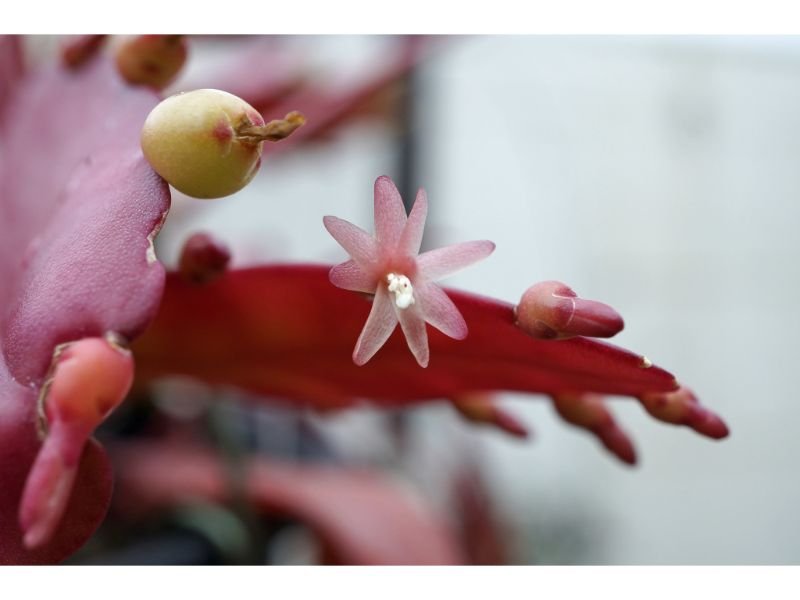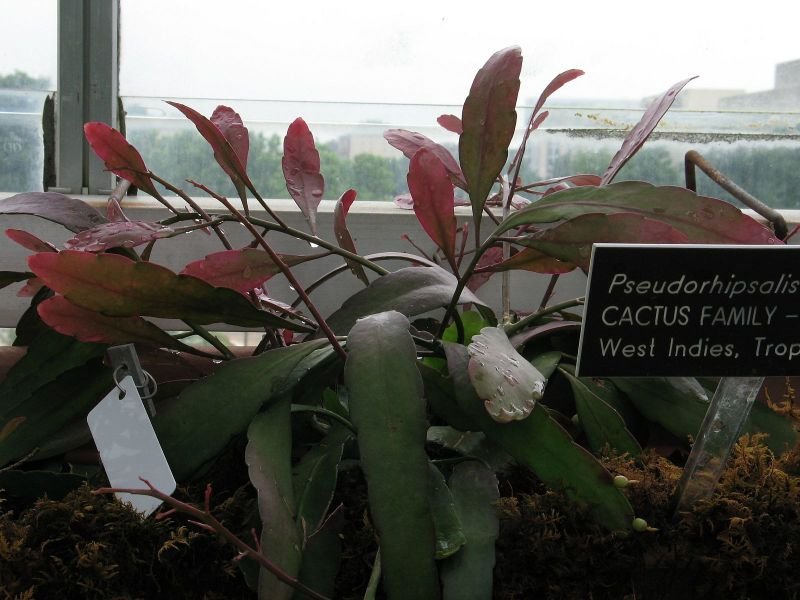Growing Pseudorhipsalis Ramulosa can be a challenging task, but with the right knowledge and techniques, you can achieve success. In this guide, we’ll cover everything you need to know about growing Pseudorhipsalis Ramulosa, including tips and tricks for success.

Table of Contents
What is Pseudorhipsalis Ramulosa?
The common name of Pseudorhipsalis Ramulosa is Red Mistletoe Cactus or Chain Cactus.
Pseudorhipsalis Ramulosa is a type of epiphytic cactus that belongs to the Rhipsalis family. It is native to the tropical rainforests of Central and South America and is commonly known as the Red Mistletoe Cactus or the Chain Cactus. It is a popular houseplant due to its attractive appearance and ease of care.
why is Pseudorhipsalis Ramulosa called red mistletoe?
Pseudorhipsalis Ramulosa is commonly known as red mistletoe cactus because of its vibrant red color and the fact that it looks like mistletoe. The plant has thin, delicate stems that can grow up to several feet long and small, pointed leaves that are usually a bright green color. However, when exposed to bright light or cooler temperatures, the stems and leaves can turn a deep red color, giving the plant a festive appearance that is reminiscent of mistletoe. Additionally, the plant has a parasitic habit, much like mistletoe, which grows on trees in the wild. Overall, the red mistletoe cactus is a beautiful and unique plant that adds a festive touch to any home or garden.
How popular is Pseudorhipsalis Ramulosa
Pseudorhipsalis Ramulosa is not as popular as some other cactus species, but it is gaining popularity among plant enthusiasts due to its unique and attractive appearance. With its long, thin, and cascading stems adorned with delicate pink flowers, it is a great addition to any collection of hanging plants. Additionally, it is relatively easy to care for, making it an ideal plant for beginners who are looking to expand their plant collection. While it may not be as well-known as some other cactus species, its popularity is definitely on the rise.
Pseudorhipsalis Ramulosa Care
Lighting Requirements
One of the most important factors in successfully growing Pseudorhipsalis Ramulosa is providing the right amount of light. This plant thrives in bright, indirect light, so it’s best to place it near a window that receives filtered sunlight. Direct sunlight can scorch the plant’s leaves, while too little light can cause the plant to become leggy and weak.
Watering Requirements
Pseudorhipsalis Ramulosa is a tropical plant and requires regular watering to thrive. However, overwatering can be detrimental to the plant’s health, as it can cause root rot. It’s best to allow the soil to dry out slightly between waterings and to water the plant deeply when you do water it.
Temperature and Humidity
Pseudorhipsalis Ramulosa prefers warm temperatures between 60-85°F (15-29°C). It also requires high humidity levels to thrive, so it’s best to mist the plant regularly or place a humidifier nearby. If the air in your home is dry, you can also place a tray of water near the plant to increase humidity levels.
Fertilizing Requirements
To encourage healthy growth, it’s important to fertilize Pseudorhipsalis Ramulosa regularly. During the growing season (spring and summer), you can fertilize the plant once a month with a balanced, water-soluble fertilizer. During the dormant season (fall and winter), you can reduce fertilization to once every two months.
Pests and Diseases
Like all plants, Pseudorhipsalis Ramulosa is susceptible to pests and diseases. Common pests include spider mites, mealybugs, and scale insects. If you notice any signs of infestation, it’s important to treat the plant with an appropriate insecticide immediately. Common diseases include root rot and leaf spot, which can be prevented by avoiding overwatering and providing proper air circulation.
What can you use Pseudorhipsalis Ramulosa for?
Pseudorhipsalis Ramulosa is primarily used as an ornamental plant, appreciated for its cascading stems and delicate pink flowers. It can be grown in a hanging basket, where its trailing stems can create a beautiful visual display. The plant is also used in floral arrangements as a cut flower. Additionally, Pseudorhipsalis Ramulosa has some medicinal properties and has been used in traditional medicine to treat conditions such as high blood pressure, diabetes, and fever. However, it is important to note that more research is needed to confirm its efficacy and safety for medical use.
How do you grow Pseudorhipsalis Ramulosa from seeds?

Growing Pseudorhipsalis Ramulosa from seeds can be a bit challenging, but it is possible with the right conditions and care. Here are the steps to grow Pseudorhipsalis Ramulosa from seeds:
- Obtain fresh seeds from a reputable source. Make sure that the seeds are viable and not too old.
- Fill a small pot with a well-draining cactus soil mix. Moisten the soil with water.
- Sow the seeds on the surface of the soil, making sure that they are evenly spaced. Do not cover the seeds with soil as they need light to germinate.
- Place the pot in a warm, bright location that receives indirect sunlight. Keep the soil moist but not soggy.
- Germination can take anywhere from two to four weeks. Once the seedlings have grown to about an inch in height, they can be transplanted into larger pots.
- To transplant, gently lift the seedlings out of the small pot and replant them in a larger pot filled with well-draining cactus soil mix.
- Water the newly transplanted seedlings thoroughly and keep them in a bright location that receives indirect sunlight. Allow the soil to dry out between waterings.
- As the seedlings grow, they will require more space and may need to be repotted into even larger pots.
Growing Pseudorhipsalis Ramulosa from seeds requires patience and attention to detail, but the result can be a beautiful and rewarding addition to your plant collection.
How do you grow Pseudorhipsalis Ramulosa indoors?

Pseudorhipsalis Ramulosa is a great indoor plant that is relatively easy to care for. Here are some steps to grow Pseudorhipsalis Ramulosa indoors:
- Choose a bright location for your Pseudorhipsalis Ramulosa. The plant prefers bright, indirect light, but can tolerate some direct sunlight. A location near a north-facing window or under artificial grow lights can be ideal.
- Plant the Pseudorhipsalis Ramulosa in a well-draining pot with cactus soil mix. Make sure the pot has drainage holes to allow excess water to escape.
- Water the plant thoroughly, allowing the soil to dry out between waterings. Avoid overwatering, as this can lead to root rot.
- Pseudorhipsalis Ramulosa prefers a humid environment, so consider placing a tray of water near the plant or using a humidifier to maintain adequate moisture levels.
- Fertilize the plant with a balanced fertilizer every 2-3 months during the growing season.
- The plant can benefit from occasional pruning to maintain its shape and promote bushier growth.
- Pseudorhipsalis Ramulosa is a tropical plant and prefers warmer temperatures, ideally between 60-80°F (15-27°C).
By following these steps, you can successfully grow Pseudorhipsalis Ramulosa indoors, enjoying its unique and beautiful appearance as a part of your indoor plant collection.
Propagating red mistletoe cactus
Propagating red mistletoe cactus (Pseudorhipsalis ramulosa) can be done through stem cuttings. Here are some steps to propagate the plant:
- Take a stem cutting of about 3-4 inches in length. Make sure the cutting has at least two or three leaf nodes.
- Remove the bottom leaves of the cutting to expose the stem.
- Allow the cutting to dry out for a day or two. This will help prevent the cutting from rotting.
- Plant the cutting in a well-draining pot with cactus soil mix. Insert the cutting about an inch deep into the soil.
- Water the cutting, making sure to keep the soil moist but not waterlogged.
- Cover the pot with a clear plastic bag or plastic wrap to create a humid environment. This will help the cutting to the root.
- Place the pot in a bright, indirect light location. Avoid placing the pot in direct sunlight as this can cause the cutting to dry out.
- After a few weeks, check for new growth. Once the cutting has established roots and new growth appears, remove the plastic cover.
- Continue to care for the new plant as you would care for a mature red mistletoe cactus.
By following these steps, you can successfully propagate red mistletoe cactus and enjoy having more of these unique and beautiful plants in your home.
In conclusion, growing Pseudorhipsalis Ramulosa requires proper lighting, watering, temperature, humidity, fertilization, propagation, and pest and disease control. By following these tips and tricks, you can successfully grow this beautiful and unique plant in your home.

Gardening is my passion and growing plants indoors has always been a stress relief for me. Grow a banana tree in my apartment once (although failed to produce bananas).






